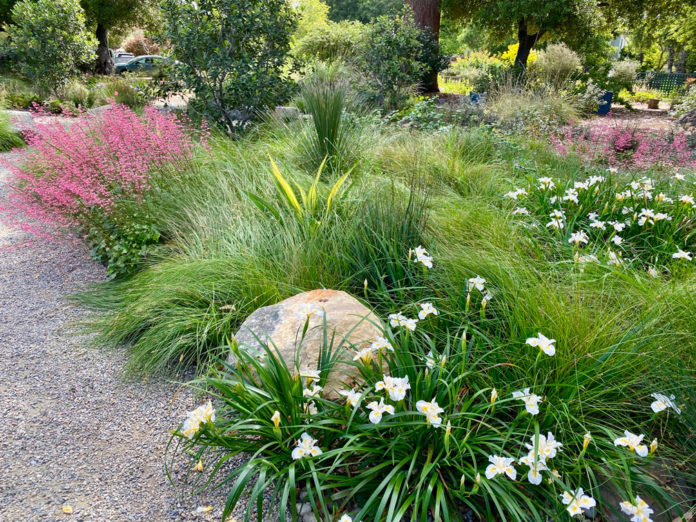Faced with what to use to keep down weeds when wood chips aren’t allowed? Well, you’re not alone. Although wood chip mulch is good for the health of your soil and your plants, it’s not recommended per new Cal Fire regulations within 30 feet of a structure. Recently I had a request from a client faced with just this dilemma. Here are some of the ground covers I recommended for her garden and for others in the past.
Living ground covers add beauty to the garden while holding the soil in place and preventing erosion. They contribute to soil health by encouraging microorganisms. A garden wouldn’t thrive as well without groundcovers.
Groundcovers are like a fancy carpet in the garden. They add richness and beauty under trees and become the stars of the show in sunny spots. Groundcovers reduce maintenance by preventing weeds and reduce watering by acting as a living mulch.
When choosing ground covers, assess the conditions of the area you want to plant:
- Is it in the sun or shade?
- Is it a naturally moist area or dry?
- Do you intend to water it or go with our natural cycle of wet in the winter and dry in the summer?
Matching the plant to the site conditions will ensure success.
When designing a plant layout consider whether you want a sweep of the same plant or a tapestry effect with a variety of plants. Using more than one type of plant allows you to work with foliage contrast, adding patterns to the composition.
Common Snowberry or Creeping Snowberry (Symphoricarpos) will hold the soil on steep banks. This native tolerates poor soil, lower light and general neglect. Evergreen Currant (ribes viburnifolium) and creeping mahonia also tolerate shady conditions. All the low growing ceanothus are great choices for sunnier spots as are the manzanita groundcovers. Smaller natives that put down deep roots are yarrow, coast aster, California fuchsia, wild grape, mimulus, buckwheat, wild rose and salvia including “Bees Bliss.”
Low water-use non-native groundcovers like cistus salviifolius, grevillea lanigera, rosemany prostratus, rubus pentalabous, correa and sarcococca are also good low-water choices.
Remember when setting plants on a steep slope to arrange them in staggered rows. Make an individual terrace for each plant and create a basin or low spot behind each one—not around the stem—to catch water. Set the crown of the plant high so it won’t become saturated and rot after watering or rain and make sure mulch does not build up around the stem.
To create stunning combinations of ground cover plants. choose 5 or 6 styles and repeat them in small drifts to carry the eye through the composition. Add grasses for linear texture. Good candidates are Blue Oat grass, a non-spreading clumping grass with silver leaves. Carex elate “Bowles Golden” is a spectacular evergreen ornamental grass and Carex tumulicola (Foothill sedge) is another good choice for a grass-like plant.
There are many more choices for groundcovers that grow in the shade. Stay tuned.
Take the opportunity to survey your garden for bare spaces that can come alive with added texture and color.
Jan Nelson, a landscape designer and California-certified nursery professional, will answer questions about gardening in the Santa Cruz Mountains. Email her at ja******@*ol.com, or visit jannelsonlandscapedesign.com.













